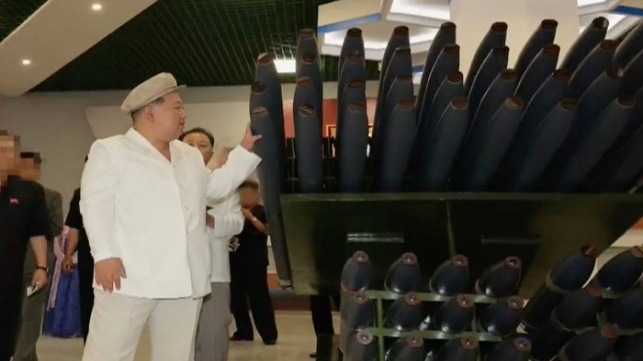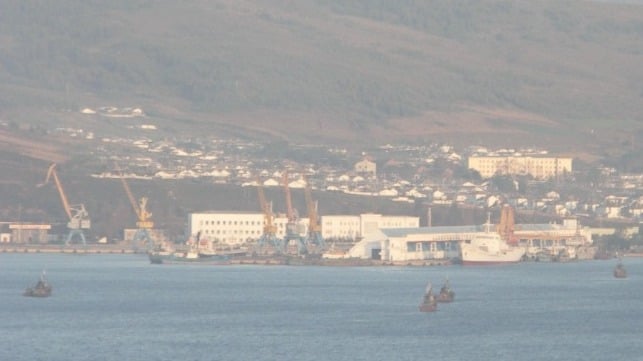WWIII
North Korean Missile Shipments to Russia Continue, but May Have Peaked

North Korean exports of artillery ammunition to Russia, for use in its war against Ukraine continue. But volumes shipped in recent weeks have fallen back from previous peaks, suggesting that initial consignments may have come from stockpiles, now depleted, with more now being met directly from production.
The traffic between North Korea and Russia has been tracked by the Open Source Centre (OSC), led by James Byrne, formerly Director Open Source Analysis at the UK’s Royal United Services Institute for Defence and Security Studies. North Korean ammunition is shipped in containers from Raijin to the Russian ports of Danube and Vostochny in the Vladivostok area. By monitoring the four Russian flagged RO-RO container ships carrying the containers - MV Angara (IMO 9179842), Lady Mariia (IMO 9220641), Maya-1 (IMO 9358010) and Lady R (IMO 9161003) - then counting the containers on board and measuring volumes, OSC has been able to accurately gauge the number of artillery shells being shipped. All four of the Russian ships are US-sanctioned, and several have also been used for hauling military cargoes to and from Tartus in Syria.
MV Maya-1 has recently come off the Sea of Japan route, loaded cargo in China, transited the Suez Canal in February and conducted a turn-round in Kaliningrad, leaving on April 10 for an unknown destination. It has apparently been unimpeded whilst in transit or during its port calls, despite being sanctioned.
OSC tracked 64 trips by the four Russian ships between September 2023 and March 2025. Traffic peaked in January 2024, when seven cargoes were shipped. By March 2025, only three cargoes per month were being shipped. Over the entire period, the 64 sailings sighted shipped a calculated 15,809 containers, with each container likely to have held 224 boxes of 152mm artillery shells, or other loads made up of rockets, 122mm or mortar rounds. Using these figures, OSC estimates that up to 6 million shells might have been shipped to Russia by North Korea by the end of March 2025.
Once unloaded at the Russian ports, the containers are moved by train directly to Russia ammunition depots servicing the Ukrainian front line. The main receiving depot at Tikhoretsk, 60 miles south of Rostov, was attacked by Ukrainian drones on September 21, 2024, with an estimated 90% of the stockpile destroyed. In 2025, Ukraine is planning on producing 3000 of its own-design Bars, Peklo and R-360 Neptune missiles, the latter of which has a range of more than 600 miles, and all of which are capable of attacking Moscow
Ukrainian defense intelligence estimates that North Korea is providing half of the ammunition currently being consumed on the Ukrainian front line. Batches of the Korean ammunition have to be proofed and separate range tables drawn up, as the performance of the Korean ammunition is inconsistent and inferior to Russia’s own production. The North Korean shells are also prone to exploding in the breach, if loaded into barrels which are hot from high intensity fire missions.
Russia is also known to receive shipments of 122mm and 152mm ammunition shells from Iran, albeit in lesser volumes. Iranian exports have tended more towards the supply of drones and missiles. Iran ships weapons through the Caspian ports of Bandar-e Anzali and Amirabad to either Kaspiysk in Dagestan or the Volga-Don trans-shipment port at Olaya. On January 2 this year, Iranian social media images showed Iranian air defense and truck-mounted Fath-360 tactical ballistic missile systems (comparable in capability to the M142 HIMARS) at the dockside at Bandar-e Anzali prior to loading.
North Korea is Shipping Billions of Dollars' Worth of Arms to Russia

North Korea has been a significant supplier of munitions to Russia for use in the conflict in Ukraine since 2022. This flow has included 152mm and 122mm artillery munitions, RPGs, and Grad rockets, critical for sustaining Russia's war effort. According to RUSI, by October 2023 an estimated 10,000 standard containers had been shipped. Now there are far more.
There have been multiple weapons transshipments from the DPRK’s port to Russia’s port in the Far East throughout 2023, 2024, and now 2025. The transportation was conducted through a sea lane between North Korea’s Rajin Port and the Dunai Military Facility in Russia, then rerouted via train through Tikhoretsk, not far from Rostov-on-Don and closer to the frontline.
According to NK Insight, satellite imagery shows that Rajin Port’s Pier 2 exported around 6,500 containers to Russia between June 2024 and February 2025. Recent analyses by Reuters and the Open Source Center indicate that the scale of arms shipments could be even larger than that: According to their findings, between September 2023 and March 2025, approximately 15,800 containers were transferred from Rajin Port in North Korea to the Russian ports of Dunai and Vostochny. Reuters made a conservative estimate that these shipments included of 4 to 6 million artillery shells, alongside other military supplies.
Based on NK Insights’ data for June 2024 to February 2025, and our evaluation based on the size and weight constraints of standard shipping containers, we estimate that the 6,500 containers shipped during this nine-month period may have contained approximately 400,000 RPG-7s, 200,000 Grad rockets, and 500,000 artillery munitions (assuming a mix of cargo). Drawing on our previous work on the North Korean arms trade, we estimate that the contents of these 6,500 containers would be worth approximately $3.25 billion.
In return for these weapons, North Korea likely receives advanced technology (possibly spy satellite and submarine warfare capabilities), luxury goods, and other needed commodities, including crude oil. This support is crucial for its nuclear program.
The shipment numbers are significant, and it is rightly believed that without North Korean munitions, Russia couldn’t keep up its high rate of consumption in the war in Ukraine. At the same time, North Korea is receiving oil by sea from Russia. Since the value of the exchange is so high for both sides, the relationship between Russia and North Korea is likely going to be stable in the short to medium term. This deepening alignment between Russia and North Korea has significant geopolitical implications for East Asia and the international order, potentially leading to a more combative North Korea.
Dr. Giangiuseppe Pili is an Assistant Professor in the Intelligence Analysis Program at James Madison University. He was previously a Research Fellow at Open Source Intelligence and Analysis at the Royal United Services Institute and is now a RUSI Associate Fellow (Proliferation and Nuclear Policy). He is a Senior Non-Resident Associate Fellow at NATO Defence College.
Cosimo Meneguzzo is an expert in business and economic analysis, as well as economic development. He has extensive experience consulting for private manufacturing and service companies, in addition to supporting public entities in policy formulation and implementation. He has founded innovative ventures and collaborated with research institutions and universities. His main publications focus on new technologies and the circular economy.
Top image: Port of Rajin, North Korea (Catriana Nicholson / CC BY SA 2.0)
The opinions expressed herein are the author's and not necessarily those of The Maritime Executive.
No comments:
Post a Comment